Unwanted facial and body hair have a great impact on the way we feel about ourselves, what we do and wear, and how we interact with others.
Options to reduce or remove unwanted hair, including waxing, plucking, and shaving are effective, but they are time-consuming and don’t give long-term results.
Are you tired of waxing, plucking or shaving and looking for a long-term solution to get rid of unwanted hair? Do you get breakouts or bumps after removing the hair?
If yes, then why don’t you consider women laser hair removal treatment which is simple, safe, and effective.
How does Laser Hair Removal Treatment Work?
It is a medical procedure that utilises a focused beam of light to eliminate unwanted hair. During the process, laser releases a light that is absorbed by the melanin in the hair.
The laser energy is transformed into heat which deactivates the reproductive cycle of hair without damaging the skin. Laser treatment disables the hair growth process for the long-term, but it doesn’t offer permanent results.
It gives outstanding results to women who have light skin tone with dark hair. However, it doesn’t give effective results to females who have a light skin tone with blonde, red, grey, and white hair.
Several sessions are required for initial hair removal, and multiple maintenance sessions might be required as well.
Why Women should Consider Laser Hair Removal Treatment?
It is used for reducing or permanently removing unwanted hair. The commonly treated areas are:
- Legs
- Armpits
- Upper lips
- Face (except for the eye area)
- Back
- Shoulders
- Neck
- Bikini line
It is possible to get rid of hair from any area, but eyelids, ears, and nose hair are not included in this list. The colour of the hair should absorb the laser light, and it should damage the hair follicle only instead of damaging the surrounding skin.
Therefore, it’s best for those who have dark hair with light skin tone. However, the technology advancements have made women laser hair removal an option who have darker skin.
If you are pregnant, then you should avoid this treatment because it’s not safe during pregnancy. However, you can try it post-pregnancy after consulting with your doctor.
Is Laser Hair Removal Treatment Permanent?
It can either permanently remove the hair or reduce the density of the hair for the long-term. Reduction in the density of the hair means hair will grow back after the first treatment and clients need ongoing laser treatment.
Permanent hair removal means hair will not grow back in the treated area after the first treatment, and no ongoing session is needed. It does not matter if the hair is reduced in density or permanently removed, it is influenced by:
- The thickness and colour of hair
- The colour of the client’s skin
- The competence and expertise of the technician
- The quality and type of laser being used
How many Treatments will you Need?
To get permanent results, follow-up sessions are essential. The exact number of maintenance sessions will vary from person to person. The majority of people only need 4 to 6 sessions every 4 to 6 weeks.
It means the whole hair removal process can take up to nine months. After every session, you will notice fewer and lighter hair.
After the first treatment, the number of hairs will decrease by 10% to 25%. To receive the best results, you will need ongoing maintenance sessions.
Depending on your skin type and hair pigment, you may require a maintenance session once or twice a year after your whole laser hair removal treatment is completed.
Benefits of Laser Hair Removal Treatment
Women who are tired of removing unwanted hair on a weekly or monthly basis should consider laser hair removal treatment benefits.
1. Minimal Pain
Some people feel a little uncomfortable in the initial treatments, but the feeling reduces with each session. After the session, a cooling gel is applied in the treated area to diminish any discomfort.
2. Zero Side Effects
Very few people experience burning from the laser, but the majority of people experience a little redness only. The redness dissipates faster, or you can apply aloe vera gel in the treated area. Laser hair removal treatment is also safe for people who have extremely sensitive skin.
3. No Ingrown Hair
No one wants to deal with unwanted ingrown hair on a weekly or monthly basis. The laser hair removal treatment destroys the hair at the root, which means you won’t have to worry about the ingrown hair.
4. Stop Hair Growth
Many people experience no new hair growth after 12 sessions or hair growth is reduced by 90%.
5. It’s Fast
The laser treatment can treat any area easily, so you can get rid of unwanted underarms hair in less than a minute. To remove hair from legs, it may take up to 30 minutes.
6. Effective
The laser is one of the most effective hair removal treatments. It damages the hair follicle rather than cutting or pulling the hair from the root, which means the results will last for the long-term.
7. Save Money
Spending money on the laser hair removal sessions may initially seem very costly, but you are actually saving your money. This treatment offers you a long-term solution. The money you have already spent on the creams, waxes, and razors are much more than fewer sessions of laser.
8. Great for the Skin
The laser doesn’t damage your skin, so there is no risk of a rash. Because the hair won’t grow back, you will have smooth skin.
9. Safe
The laser is the safest hair removal method because it is performed by a trained and highly qualified practitioner. There is no risk of receiving an allergic reaction to harsh chemicals or cutting yourself.
Side Effects of Laser Hair Removal Treatment
- Redness or irritation
- Discomfort
- Crusting
- Changes in skin colour
- Risk of skin infection
- Scars
- Burns and blisters
Conclusion
If you have resources and willingness, laser hair removal is undoubtedly an effective and safe approach when performed perfectly. To get rid of unwanted hair completely, it may take several treatments, but permanent hair removal is not guaranteed as it varies from person to person.


